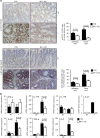Th17-type cytokines, IL-6 and TNF-α synergistically activate STAT3 and NF-kB to promote colorectal cancer cell growth
- PMID: 25174402
- PMCID: PMC4493653
- DOI: 10.1038/onc.2014.286
Th17-type cytokines, IL-6 and TNF-α synergistically activate STAT3 and NF-kB to promote colorectal cancer cell growth
Abstract
Colorectal cancers (CRCs) often show a dense infiltrate of cytokine-producing immune/inflammatory cells. The exact contribution of each immune cell subset and cytokine in the activation of the intracellular pathways sustaining CRC cell growth is not understood. Herein, we isolate tumor-infiltrating leukocytes (TILs) and lamina propria mononuclear cells (LPMCs) from the tumor area and the macroscopically unaffected, adjacent, colonic mucosa of patients who underwent resection for sporadic CRC and show that the culture supernatants of TILs, but not of LPMCs, potently enhance the growth of human CRC cell lines through the activation of the oncogenic transcription factors signal transducer and activator of transcription 3 (STAT3) and nuclear factor-kappa B (NF-kB). Characterization of immune cell complexity of TILs and LPMCs reveals no differences in the percentages of T cells, natural killer T cells, natural killer (NK) cells, macrophages and B cells. However, T cells from TILs show a functional switch compared with those from LPMCs to produce large amounts of T helper type 17 (Th17)-related cytokines (that is, interleukin-17A (IL-17A), IL-17F, IL-21 and IL-22), tumor necrosis factor-α (TNF-α) and IL-6. Individual neutralization of IL-17A, IL-17F, IL-21, IL-22, TNF-α or IL-6 does not change TIL-derived supernatant-driven STAT3 and NF-kB activation, as well as their proproliferative effect in CRC cells. In contrast, simultaneous neutralization of both IL-17A and TNF-α, which abrogates NF-kB signaling, and IL-22 and IL-6, which abrogates STAT3 signaling, reduces the mitogenic effect of supernatants in CRC cells. IL-17A, IL-21, IL-22, TNF-α and IL-6 are also produced in excess in the early colonic lesions in a mouse model of sporadic CRC, associated with enhanced STAT3/NF-kB activation. Mice therapeutically given BP-1-102, an orally bioavailable compound targeting STAT3/NF-kB activation and cross-talk, exhibit reduced colon tumorigenesis and diminished expression of STAT3/NF-kB-activating cytokines in the neoplastic areas. These data suggest that strategies aimed at the cotargeting of STAT3/NF-kB activation and interaction between them might represent an attractive and novel approach to combat CRC.
Figures






References
Publication types
MeSH terms
Substances
LinkOut - more resources
Full Text Sources
Other Literature Sources
Medical
Molecular Biology Databases
Miscellaneous

